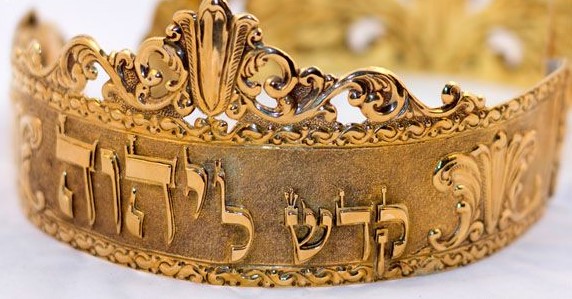The Name of Yehovah is Above All
The Name of the Creator Yehovah is the name above all names. The letters of the Set-apart Name Yehovah have an atonement power, as we will see in this article.

The High Priest’s head-plate reads: “And you shall make a plate of clean gold and engrave on it, like the engraving of a signet: SET-APART TO YEHOVAH”. (Exo 28:36)
“And you shall make a plate of clean gold and engrave on it, like the engraving of a signet: SET-APART TO YEHOVAH”. (Exo 28:36)
וְעָשִׂיתָ and you will make צִּיץ blossom זָהָב of gold טָהֹור pure
וּפִתַּחְתָּ and (engrave) open עָלָיו on פִּתּוּחֵי engravings) openings)
חֹתָ֔ם seal of קֹדֶשׁ set-apart לַֽיהוָֽה to Yehovah
The word translated above as a plate is tsits but this does not do justice to the literal meaning of this Hebrew word. The word tsits can be written in two forms in Hebrew like this: צץ/ציץ; but in the ancient Paleo Hebrew pictographs, the word tsits has the meaning to flower, to bloom, or to blossom.
The ancient Hebrew pictograph presenting sprouting seeds, or something that germinates, leads us to the literal meaning of the word tsits, a blossom. And what is the purpose of the blossom? Most importantly the function of the blossom is to produce the fruit of the tree.
This literal meaning of tsits can be seen in Psa 103:15:
As a flower (tsits) of the field, so he flourishes.
And also, in Num 17:8:
And it came to be on the next day that Mosheh went into the Tent of the Witness and saw that the rod of Aharon, of the house of Levi, had budded, and brought forth buds, and blossomed (tsits) blossoms (tsits) and bore almonds.
Whether the gold tsits Aharon had on his forehead was in a rectangular shape (as per the tradition) or it was in some kind of shape of blossom may not be in such importance. What is important is that in the Hebraic mind the tsits brings fruits and Aharon as a High Priest was to bring fruits, too. This tsits was put on a blue cord and on the turban (Exo 28:37). We should notice that these four garments: ephod, breastplate, cloak, and tsits are exclusive to the High Priest. Therefore, we may say, when Yeshua the Hebrew Messiah said to his Hebrew disciples “By their fruits you shall know them” they knew exactly what He was talking about. A related word to tsits is the word tsitsit: ציצת, as found in Num 15:38-39:
Speak to the children of Israel, and you shall say to them to make tzitziyot (plural) on the sides of their garments throughout their generations, and to put a blue cord in the tzitzit of the sides. And it shall be to you for a tzitzit, and you shall see it, and shall remember all the commands of Adonai and shall do them.
Another literal application of the word tsits/tsitsit is found in Eze 8:3:
And He stretched out the form of a hand and took me by a lock (tzitzit) of my hair. And the Spirit lifted me up between the earth and the heavens, and brought me in visions of Elohim…
Hence, we find that a tsitsit should have a form of a tassel or lock of hair, as indeed it has.
When Mosheh gave the Torah to the Hebrews, they first heard that the High Priest was to wear a tsits on a blue cord on his forehead and later they heard that they too were to wear tsitsiyot (plural of tsitsit) with a blue cord on their sides.
In conclusion, when the High Priest had to judge, whoever stood before him waiting for judgement would look upon the radiance of the letters with glittering emitting light on the gold plate and see his face reflecting on them. Since the plate had the Name Yehovah engraved on it, and upon seeing it he would feel ashamed for the sin he had done. Or, whoever had to swear to tell the truth, he would think twice and even thrice before swearing falsely before the Name of the Creator Yehovah. Thus, the letters of the Set-apart Name Yehovah engraved upon the plate had an atonement power so that whoever looked upon the radiance of the letters, his face would fall in terror and his heart would break.
Thus, the Tsits had a public reflection of one’s actions, one felt ashamed for what he had done, and he would feel not only guilty about some past misdeed, but ashamed, too.
The Bible Code and the Name of the Creator
In the Hebrew text of Exo 28:36 above, starting with the last letter in the last word (in red) which is the Name of YHVH and reading from left to right only the last letters of which word spells haShem yo’ter, “the name is superior, above, over, to exceed.” Therefore, in context of the text on the surface we read the hidden message of YHVH on the front of the turban of the High Priest.
“The Name of Yehovah is above all”
For more insight on how to pronounce the Name of YHVH, read the article The Hebrew Yehovah vs. the Roman Yahweh.
Knowledge known to only a few will die out. If you feel blessed by these teachings of Time of Reckoning Ministry, help spread the word!
May we merit seeing the coming of our Mashiach speedily in our days!
This page contains sacred literature and the Name of the Creator. Please, do not deface, or discard, or use the Name in a casual manner.
